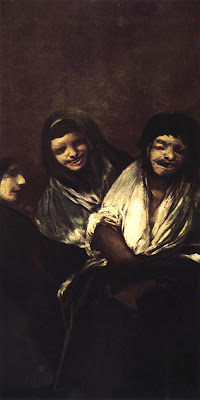Francisco de Goya y Lucientes, The Duke and Duchess of Osuna and their Children, 1787-1788
This morning, in ArtDaily.org's "On a Day Like Today" feature, I read and noted that it was the one-hundred eighty-third anniversary of Francisco Goya's death in Bordeaux, France.
When I was growing up, my family (my mother, particularly) made a practice to honor death anniversaries, something my wife disagrees with.
Caroline much prefers marking the birthdays of the departed instead and I’m generally inclined to follow suit.
In Goya's case, however, since this morning's apprehension came up so suddenly, and because he's Goya (meaning a very great artist), I think making an exception today is entirely appropriate.
Francisco de Goya y Lucientes, La Leocadia o Una manola, 1819-23
I first deeply experienced Goya's art in a Modern Painting survey course given by Professor Hedley Rhys during my sophomore year at Swarthmore College. The following year, in a Master Printmakers seminar taught by Professor Robert Walker, I was extremely fortunate by being given the opportunity to study and actually physically handle many of Goya’s graphic works (including Los Caprichos, The Disasters of War and others) at the Lessing Rosenwald Collection over the course of many Wednesday afternoons during 1973 and 1974.
Francisco de Goya y Lucientes, Capricho 43. El sueño de la razón produce monstruos, 1797.
I once read someone's comment describing Goya as the last of the Old Masters and the first modern artist. While one can (and people would) quibble that observation to death (these kinds of arguments can be fun and are occasionally elucidating), the remark also makes a good deal of sense also and resonates in the mind and eye. One definitely feels the tug of the pre-Industrial Revolution world looking back toward classical antiquity (and, frankly, much further back in time and consciousness) in Goya. But, as the Surrealists, among others, noticed, Goya powerful thought-images also seem quite contemporary in the way he depicts and seems to unravel deep human psychology in his portraiture and other works. The penetrating and lucid renderings of a jaundiced waking eye and of a bad-dreaming eye are always fully present-tense expressions of self. They seem as vivid as today and as imminent as tomorrow.
Francisco de Goya y Lucientes, Bandit Killing a Woman, 1798
Discovering Goya coincided with the beginning of my own transformation from being primarily literary to visual in orientation, which was a necessary adaptation for someone trying to pursue a career in art history and the mental change that has probably afforded me the greatest pleasure in life. Somewhere along the way, I recall reading about Goya's mastery and control of the "gray" or neutral palette and how this allied him with earlier artists like Velasquez, Rembrandt and Chardin and later masters like Manet, Whistler and Juan Gris. I remember pondering this deeply and trying to discern where that perception led and how it might be applied, leading me to devise and spin for a period all sorts of foolish, expansive student theories that never affected or influenced anyone’s thinking but my own.
In the end, I became a lawyer (in the immortal words of The Ethiopians, "Everything Crash").
Goya remained Goya, something fine, great and immortal in the world.
Francisco de Goya y Lucientes, Mujeres riendo, 1819-1823
It's funny -- for the last couple of years I've thought of moving to Bordeaux. We shall see.
Commemorative plaque outside Goya's House, Bordeaux, France








No comments:
Post a Comment